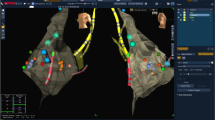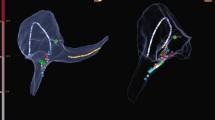Abstract
A pseudo r′ in V1 during supraventricular tachycardia (SVT), but not during sinus rhythm is pathognomonic for AV nodal re-entry tachycardia (AVNRT). During radiofrequency (RF) energy delivery, stability of the catheter tip is crucial. Intra-procedural catheter and patient movement as well as abrupt rhythm changes can lower efficacy, prolong procedural time, and contribute to the risk of AV block.
Objectives: A novel streamlined approach using a single sheath and two catheters was evaluated that leverages the patient’s own anatomy to help stabilize catheter position during RF application and localize RF targets.
Methods: Twenty-five consecutive patients presenting with documented SVT were ablated using a single sheath technique with only two catheters. A 12F 75 cm sheath was inserted via the right femoral vein and its tip is placed at base of the right atrium (RA). Through this sheath a 6F coronary sinus (CS) catheter and 6F ablation catheter are placed. After confirming the diagnosis of AVNRT, the ablation catheter tip is positioned anterior to the CS os in the slow pathway region. During RF application, the mobility constraints of the “sheath-catheter-catheter” complex provide excellent electrogram and catheter stability by taking advantage of the “collaring” effect of the sheath which is in turn “anchored” to the diagnostic CS catheter.
Results: Acute procedural success was 100% with no apparent complications. Flouroscopy time was modest (8.5 min (range 3.1–22)) as were the case times (mean 120 min (range 52–206)). Cost savings compared to “3 cath-3 sheath” approach was $113 U.S. and would be much larger if compared to newer non-flouroscopic navigational systems or using alternative ablation energy sources.
Conclusions: This new approach minimizes ablation catheter tip movement on the slow pathway region providing a safe, successful, speedy, and economical alternative to a traditional 3 or 4 catheter approach in appropriately selected SVT patients.
Similar content being viewed by others
References
Scheinman M, Calkins H, Gillette P, Klein R, Lerman BB, Morady F, Saksena S, Waldo A; North American Society of Pacing and Electrophysiology NASPE policy statement on catheter ablation: Personnel, policy, procedures, and therapeutic recommendations. PACE 2003;26:789–799.
Shah D, Haissaguerre M, Gaita F. Slow pathway ablation for atrioventricular nodal reentry. J Card Electro 2002;13:1054–1055.
Strickberger SA, Morady F. Catheter ablation of atrioventricular nodal reentrant tachycardia. In: Zipes DP, Jalife J, eds. Cardiac Electrophysiology: From Cell to Bedside. W.B. Saunders Co., Philadelphia 2000:1028–1035.
Hayashi M, Kobayashi Y, Miyaughi Y, Ino T, Atarashi H, Takano T. A randomized comparison of the straight linear approach with electrogram mapping focal approach in selective slow pathway ablation. PACE 2001;24:1187–1197.
Taylor GW, Kay GN. Selective slow pathway ablation for treatment of AV nodal reentrant tachycardia. In: Huang SKS, Wilber DJ, eds. Radiofrequency Catheter Ablation of Cardiac Arrhythmias: Basic Concepts and Clinical Applications, 2nd ed. Armonk, NY: Futura Publishing Co., 2000:423–461.
Estes NA 3rd. Catheter cryoablation of supraventricular tachycardia: Quo vadis? Heart Rhythm 2004;1:139–140.
Cooke PA, Wilber DJ. Radiofrequency catheter ablation of atrioventricular nodal reentrant tachycardia utilizing nonfluoroscopic electroanatomical mapping. PACE 1998;21:1802–1809.
Senatore G, Carreras G, Taglieri C, et al. Catheter ablation of nodal re-entrant tachycardia using Locallisa navigation system. Cardiostim 2002, Nice, France (Abstract).
Ernst S, Ouyang F, Linder C, Hertting K, Stahl F, Chun J, Hachiya H, Bansch D, Antz M, Kuck KH. Initial experience with remote catheter ablation using a novel magnetic navigation system: Magnetic remote catheter ablation. Circulation. 2004;109(12):1472–1475.
Ng GA, Lau EW, Griffith MJ. A streamlined “3-catheter” approach in the electrophysiological study and radiofrequency ablation of narrow complex tachycardia. J Int Cardiac Electro 2002;7:209–214.
Blomstrom-Lundqvist C, Scheinman MM, Aliot EM, Alpert JS, Calkins H, Camm AJ, Campbell WB, Haines DE, Kuck KH, Lerman BB, Miller DD, Shaeffer CW, Stevenson WG, Tomaselli GF, Antman EM, Smith SC Jr, Alpert JS, Faxon DP, Fuster V, Gibbons RJ, Gregoratos G, Hiratzka LF, Hunt SA, Jacobs AK, Russell RO Jr, Priori SG, Blanc JJ, Budaj A, Burgos EF, Cowie M, Deckers JW, Garcia MA, Klein WW, Lekakis J, Lindahl B, Mazzotta G, Morais JC, Oto A, Smiseth O, Trappe HJ; European Society of Cardiology Committee, NASPE-Heart Rhythm Society. ACC/AHA/ESC guidelines for the management of patients with supraventricular arrhythmias—executive summary. A report of the American college of cardiology/American heart association task force on practice guidelines and the European society of cardiology committee for practice guidelines (writing committee to develop guidelines for the management of patients with supraventricular arrhythmias) developed in collaboration with NASPE-Heart Rhythm Society. Review. J Am Coll Cardiol 2003;42(8):1493–1531.
Baker JH II, Plumb VJ, Epstein AE, Kay GN. PR/RR interval ratio during rapid atrial pacing: A simple method for confirming he presence of slow AN nodal pathway conduction. J Cardiovasc Electrophysiol 1996;7:287–294.
Knight BP, Zivin A, Souza J, Flemming M, Pelosi F, Goyal R, Man C, Strickberger SA, Morady F. A technique for the rapid diagnosis of atrial tachycardia in the electrophysiology laboratory. J Am Coll Cardiol 1999;33:775–781.
Knight BP, Ebinger M, Oral H, Kim MH, Sticherling C, Pelosi F, Michaud GF, Strickberger SA, Morady F. Diagnostic value of tachycardia features and pacing maneuvers during paroxysmal supraventricular tachycardia. J Am Coll Cardiol 2000;36(2):574–582.
Gimbel JR. A novel streamlined “anchored” anatomical approach to ablation of AVNRT. Heart 2004;90(7):803.
Duru, F. CARTO three-dimensional non-fluoroscopic electroanatomic mapping for catheter ablation of arrhythmias: A useful tool or an expensive toy for the electrophysiologist? Review Anadolu Kardiyol Derg 2002;2(4):330–337.
Author information
Authors and Affiliations
Corresponding author
Rights and permissions
About this article
Cite this article
Gimbel, J.R. A Streamlined, Anchored, Anatomical Approach to Ablation of Atrioventricular Nodal Reentry Tachycardia: Preliminary Report of the First 25 Cases. J Interv Card Electrophysiol 12, 143–148 (2005). https://doi.org/10.1007/s10840-005-6550-6
Received:
Accepted:
Issue Date:
DOI: https://doi.org/10.1007/s10840-005-6550-6




